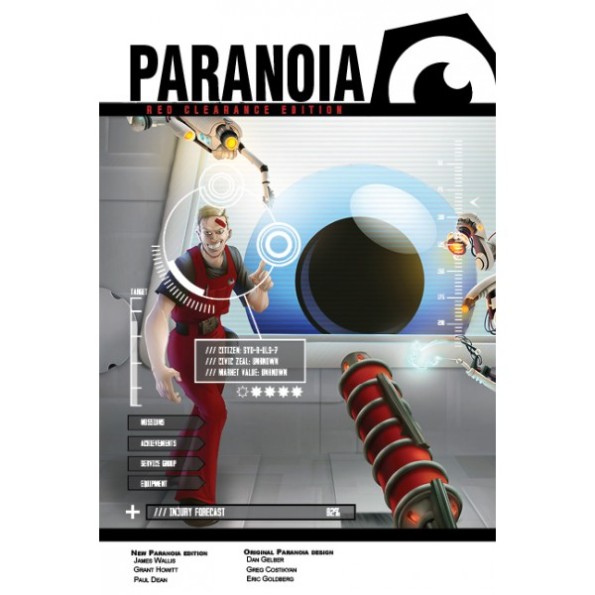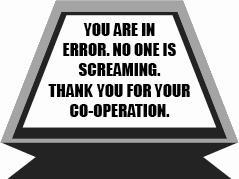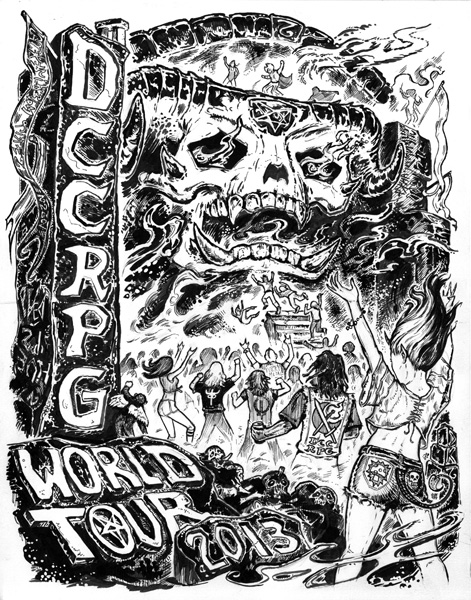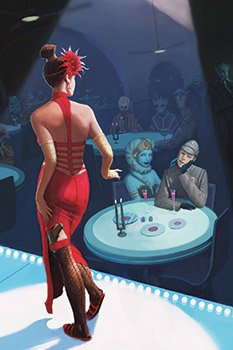Archive
The Black Hack 2e Review
 I had heard of the Black Hack in various Old School Renaissance (OSR) communities on the now doomed G+ RPG communities, but hadn’t looked in to it until recently. The publisher had a kickstarter over the summer that flew completely under my radar, but since the 126-page second edition PDF was only $6, I decided to take a gamble.
I had heard of the Black Hack in various Old School Renaissance (OSR) communities on the now doomed G+ RPG communities, but hadn’t looked in to it until recently. The publisher had a kickstarter over the summer that flew completely under my radar, but since the 126-page second edition PDF was only $6, I decided to take a gamble.
I am so pleased that I did. I have no experience with the first edition of the Black Hack, but the amazing resources in the second edition provide an easy to learn system for players, and a wealth of creative tools for GMs. This is one of the few systems that I would *not* bring pre-gens for in a convention setting. The entire player section of the game is a scant 30 pages, and character generation is TWO. Each of the included classes (the classics: Warrior, Thief, Cleric, Wizard) has a simple character sheet and just enough options to give your character a few interesting bits of equipment and mechanics. Each of the four classes can be printed on a single sheet, front and back, and the player will have just about everything they need.
am so pleased that I did. I have no experience with the first edition of the Black Hack, but the amazing resources in the second edition provide an easy to learn system for players, and a wealth of creative tools for GMs. This is one of the few systems that I would *not* bring pre-gens for in a convention setting. The entire player section of the game is a scant 30 pages, and character generation is TWO. Each of the included classes (the classics: Warrior, Thief, Cleric, Wizard) has a simple character sheet and just enough options to give your character a few interesting bits of equipment and mechanics. Each of the four classes can be printed on a single sheet, front and back, and the player will have just about everything they need.
This system is a great example of the mechanics aiding creativity and story-telling, and not getting in the way with endless fiddly bits. For example: one of the core mechanics is the attribute test. Your attributes are generated via the classic 3d6 method. Roll under the attribute called for in the test, you pass. Roll over, you fail. Initiative is a great example of this: roll under your Dexterity. Pass? Go before the baddies. Fail? Go after the baddies. Quick. Easy to remember. Fun!
It also makes use of the popular advantage/disadvantage mechanic used in D&D 5e. Since you want to roll under your attribute, you would take the lower result for advantage, and the higher result for disadvantage.
Another nice mechanic it uses for item tracking is the usage die chain. This is used to track anything that has a number of uses like arrows, holy water, oil etc. When you use the thing, roll the associated usage die. If you roll a 1 or a 2 it goes down one step in the chain: D20 > D12 > D10 > D8 > D6 > D4 > expended. For ammo it is only rolled at the end of the encounter. This is a nice way to reflect a limited resource without the dreaded Dungeons & Accounting that can take up so much time or is completely ignored by players and GMs in other systems.
The art is very cool black and white pieces from Karl Stjernberg, David Black, Sean Poppe, and Jeff Call. A lot of the best work is reserved for the monster and opponents section.
But the best part is reserved for the GM. This system has incredible resources to generate just about anything you could need for a game session: NPCs, hex maps, wilderness, dungeons, settlements, taverns, quest hooks, whats on the body etc. Some are straight rolls of a d12 or d8, others use 2d6 on a matrix, others are drop tables that have different results based on where the die lands on the page. This is the most succinct, concentrated creativity toolkit I’ve seen in any system. Even the monsters and opponents section includes tables to make every encounter unique.
If you’re in a creative rut, this is about the best $6 you can spend. If you’d like to pre-order the printed version and missed out on the kickstarter (like I did), check out the pre-order page. See you around the table! I’ve got some adventures to generate!
HAPPINESS IS MANDATORY; A review of Mongoose’s new take on the Paranoia RPG

Paranoia has been around for decades, and is a game I was in love with 20 years ago. Recently, I picked up and read (cover to cover) Mongoose’s take on life in our beloved Alpha Complex, and found that not only was happiness mandatory, but it was pretty darn easy to comply.
If you’ve never seen the game before, Paranoia is a darkly humorous RPG where you play a citizen of Alpha Complex, a sealed vast complex of various sectors built to survive some great calamity. Alpha Complex is controlled by The Computer, a semi-omnipotent semi-insane artificial intelligence that has, over hundreds of cycles of operation, turned Alpha Complex into an Orwellian witch hunt for commies, mutants, and members of secret societies. Traditionally, you play a faithful troubleshooter just above the minimum security clearance level, who also happens to be a mutant and a member of a secret society. You have six clones (because a computer knows something about backups), and death comes easily. Most games typically involve hunting each other, incriminating yourself, hunting threats to the complex, and getting blown up in a variety of dramatic hilarious ways, from simple R&D product testing to actual threats.
Mongoose has done little to change this classic formula thematically, but has done a great job of sprucing up the rules and play of the game to match the character the game has always carried with it. Here are the primary changes for long time players:
- Cards have been added to make equipment and duties easier to keep track of, and have created action cards you can use add story elements or interrupt another players action to make things interesting. Since screwing over the guy sitting next to you is half the fun, it makes for creative fast paced play.
- Skills are tested by rolling dice and tracking 5’s or 6’s (with all rolls of 1-4 taking away a success if the player has a negative skill number, or being ignored with a positive skill number). Players are encouraged to make creative combinations of their four Stats (Violence, Brains, Chutzpah and Mechanical) and a large list of skills.
- Along with your skill dice, you roll a “Computer Dice” (they say Dice because the word ‘die’ is used too much already in the book). Rolling a Computer on the Computer Dice forces a player to lose “Moxie” (your ability to cope) and represents either equipment malfunction or the Computer’s helpful interference pushing the player closer and closer to the breaking point. Run out of Moxie and you lose it in the way that is funniest at the time.
- Commies are now termed the more generic “terrorists” (though you still can and do have commie terrorists, so that’s pretty much the same.
- All characters are implanted at birth with a Cerebral Cortech and cyber-eyes which allow the computer to beam programs straight into the character’s brain, as well as video treason with the characters own eyes as witnesses for (or against) them.
- Players now perceive in augmented reality, with name tags and “treason stars” floating above other players. 5 stars and you’re laser fodder.
- Players are awarded “XP Points” by the Computer for positive actions and behavior, and are docked XP Points for negative or treasonous behavior. XP Points can be used to buy skill and stat upgrades, software packages, and security clearance upgrades, complete with cake to celebrate with.

I won’t get into some of the rules that the GM uses, as they are above your security clearance, but I’ll summarize by saying that they remain fast and loose, and easy for any GM to apply. The players often times end up making things more interesting than the GM could ever manage through attempts at creative problem solving.
Overall, Mongoose’s take on the game emphasizes creativity and minimizes mechanics, which really has always matched the particular play style of this game. You don’ win Paranoia, you survive it.
The main box comes with five dry erase character sheets, a players book, a GM book (which made me laugh out loud reading it several times), and book with three adventures in it that start off with the players at infrared status (minimum security status) and moving their way up, learning alpha complex as you go. It’s a great series of adventures because it presumes no knowledge of the system and lets players learn. It also is written in such a way that the GM can read that first and run the game before reading the rules. It’s pretty amazing and a great way to jump right in.
Pick this game up if your friends can enjoy sabotaging each other with hilarious consequences and you’re a GM capable of thinking on your feet to make things fun. It’s a great change of pace from the same old fantasy game and makes for a great one shot in between campaign sessions.

Formula Kart – Adding Mario Kart items to Formula D
 Yesterday I watched the Monaco Grand Prix F1 race from start to finish. I had never really paid much attention to F1 racing before, and this was quite the dramatic race. Check out the highlights if you missed it.
Yesterday I watched the Monaco Grand Prix F1 race from start to finish. I had never really paid much attention to F1 racing before, and this was quite the dramatic race. Check out the highlights if you missed it.
Monaco is the track that comes with the board game Formula D. I’m such a big fan of the game I own all the expansions which include F1 tracks from around the world. The game is a lot of fun in its own right, but some games can turn to run away victories with a few fortunate rolls of the gear dice. This got me thinking about other racing games I love, like Super MarioKart.
If you are looking to add another layer of excitement, and to add some randomness and equalizers to the race, just add Mario Kart items! For the uninitiated, in MarioKart when your Kart runs over a question mark box, you get an item that can help you in the race. At this point there have been a lot of MarioKart games, and with them a lot of different items with different effects. Some would be more difficult to simulate in a board game than others. Here are my suggestions.
Use the red debris markers to simulate the the boxes, adding one per player. For a one lap game, I would suggest adding them half-way through the lap, for a two lap game, I would add them just before the finish line, or in both places if you want a lot of items! Once a car runs over the box, that player rolls the standard d20 “danger die” to determine what item is received. I’ve mixed and matched items from several different versions of MarioKart to make the mechanics easier to handle.
I’ve borrowed a few mechanics from 5th Edition D&D for the shells. While the game comes with one standard d20, I would recommend adding a few more to the box if you’ve got a few lying around (and if you’re nerdy enough to be reading this, you probably do!). For green shells its just a simple contested roll: both attacker and defender roll a d20, if the attacker has the higher result, the shell hits and the defender spins out. If the defender has the higher result, the shell misses! Red shells work the same, except the attacker rolls 2d20 (advantage in 5th ed. terms) while the defender still only rolls 1d20. Highest result wins, if its the defender, the red shell misses!
Download the full table here. I hope you guys enjoy this expansion to the rules. Watch out for blue shells!
Resurrection Revisited
 The Easter season is a time that rebirth is on our minds, with the backdrop of the story of the Resurrection prominent for many, and the revitalization Spring brings.
The Easter season is a time that rebirth is on our minds, with the backdrop of the story of the Resurrection prominent for many, and the revitalization Spring brings.
It made me think about the role of resurrection and ‘raise dead‘ in fantasy role playing. Most systems have something of this sort at some level of play, and conquering death is one of the big fantasies we have in reality and fiction. That said, as an element of a gaming setting, it’s a complete game changer. And here’s the thing: It is horrible.
Resurrection ruins games. It ruins good story-telling. It cheapens heroism, belittles triumphs, and obliterates drama. It destroys the impact and gravity of the greatest story telling device there is: Death. Without death, there is no finality, no consequences to any event that can’t be unmade or recycled. Heroes need not live up to a higher standard where they might just prevail by way of a Holy Mulligan. It’s a softening of the game world that detracts from the story, and thereby detracts from the game itself.
We finished up Paizo’s Reign of Winter adventure path this past year. After we hit the midway point of the series, it became apparent that the presence of raise dead and resurrection was quickly arrived at as the easy remedy for character death. A shoulder shrug followed by a quick calculation of how many diamonds it would deplete from the party stores was all the drama that such an event as character death added. It was a failure of the system if not myself, the storyteller. Death had lost its finality, and the threat of death was greatly offset by the players calling my bluff of a TPK, which I theoretically wouldn’t let happen (though I would, with some caveats that I went into last year in my article “The Art of Fail“) . That is a problem.
Outside of a softening of the consequences, it is problematic from a general story telling perspective. How can the loss of life of villagers in a goblin raid remain poignant when someone can walk up and raise the victims? Why stop there? Why not raise random people of historical note? The King murdered? Bring ’em back? It only takes 10 minutes in some of these systems, so he might not even be missed! It cheapens the value of life and the story telling dynamic, and creates numerous plot holes that are hard to work around without clumsy artifice on the part of the GM.
And you shouldn’t do that! Resurrection and Raise Dead should be rare, almost wish-like events that are costly. Costly, painful rituals for a loved friend and companion, like we see in Conan the Barbarian. Some of these costs are built in, but if it’s just money, it’s a pittance (get a character to sacrifice their most powerful magic item and you’ll see them weep openly). Promises should be required to raise the dead. Oaths. Blood sacrifice.
Some of you might have played under old rules in OD&D that indicated that an elf could not be resurrected. We did, back in 1997, and when a elven ranger died at the hands of a certain Troll in the Temple of Elemental Evil, we all realized that he was DEAD DEAD, and it sobered the players that evening. When not long after, a paladin of St. Cuthbert was mostly devoured by rats, the drama of her resurrection was a story in itself; an epic race to the nearest city that had a priest of sufficient level to raise her, a debt undertaken, oaths sworn, and a battle with a cult of Iuzian priests fighting to interrupt the ritual. The resurrection became a story in itself, and carried weight.
It’s a hard choice to ditch resurrection or deny its availability to players. They will hate you for it, so you had better telegraph those decisions early on before it becomes a resource they anticipate. When the playing field is clear before hand, few have reason to complain (especially where the challenges are freely taken and understood). Games that let you know that they plan on killing you can be strangely refreshing, like Paranoia (giving you six clones is a good indicator of the cheapness of human life) or Dungeon Crawl Classics, where the 0-level funnel has you generate 3 to 4 peasants who try to try to survive a normal first level adventure (protip: your most unworthy character will always be the sole survivor). While seemingly depressing, the result is a certain lack of attachment for more lighthearted games, which is surprisingly welcome. Alternately, for more serious games, a grim determination and earnest concern for other characters becomes more pressing.
Perhaps the biggest downside to this approach is when it takes effect, and a favorite character is gone without the realistic possibility of a remedy. Sometimes, this can be a game-ending or campaign-ending event, especially if more than one character bites the bullet. My advice is to play through it and see if you can’t come out on the other side. That said, you know your players. The point, is to have fun (Commandment #10) so as long as folks are having a good time, it’s worth it, but remember you may have missed an opportunity for players and characters to grow a little, which could lead to even better results.
Try it on, or say you’re going to, and see how it changes your player’s play-style. You might just be surprised what the fear of death will do for your next game.
Generators or Degenerators? The Mixed Blessing of Character Generator Culture
 Guest Post by Matt Orbach
Guest Post by Matt Orbach
Recently, Pathguy got a letter from WOTC, politely asking that he remove his 5E character generator and any other content that might be their IP. I’m not going to discuss that choice here; what WOTC did was legal, and there are boards aplenty debating the matter. Suffice it to say that what you can do legally and what you can do wisely do not always coincide.
But it put to the question, do these generators really help the game, or do they remove us too far from the fundamentals? As it happened, I hadn’t visited this page in quite a while, but I was reminded of it as a tool to help level a 5E character.
Pathguy’s generator was a great tool. When I found it was unavailable, I was forced to level up by hand. As it turned out, leveling by hand was very easy for 5E, although this is not always the case for all rules systems. It caused me to wonder how reliance on character generators for popular systems had shaped the quality of play from a GM perspective and from a player perspective.
THE GM PERSPECTIVE
As a GM, I come to a game with a set of expectations as to what my players will do during a session, including, but not limited to:
• know most of the rules, and ask questions about the others
• learn how characters and the game world interact
• pay attention
• enjoy the narrative of the story-line
• act out characters
• collaborate with the other players
• have fun
I’ve also come to understand that a group of committed players enjoying themselves will typically do about 75% of these; which is fine, as long as “have fun” is somewhere in there. It might be great for everyone to come prepared with a carefullly researched and crafted character, and it probably makes for a richer, deeper game, but realistically it just won’t always happen.
To enjoy a game a player has to have an understanding of what they are doing. A character generator that removes that understanding inhibits enjoyment of the game by making the character mechanically incomprehensible for most play systems. A good build is useless without some knowledge of its implications, and inhibits having fun if it is mysterious and incomprehensible to the player.
THE PLAYER PERSPECTIVE
As a player, I have slightly different expectations. I know the groups I’ve played with all seem to enjoy different aspects of the game. These can be primarily broken into two groups:
The Artist
This player enjoys creating interesting characters, sometimes with unexpected traits. Some temper this so the character can be effective in the game world, and thus more involved in the story. For others, the reverse seems to be true: they start from a fairly blank slate and draw out the character from the actions taken during gameplay, laboring only to create one who will take effective actions. Still others go further to extremes, creating bizarre and often unplayable characters.
The Engineer
There may very well be a graphing calculator or spreadsheet involved, because these folks enjoy the mathematical permutations and precise calculations of creating a character that is purpose-built. While personality and story is a factor, it is secondary to the build mechanic.
I fall primarily into the first category myself. There’s a certain appeal, I’ll admit, to the Engineer, but I lost my love for that sort of endeavor years ago. You see, I spent a summer designing mecha upon mecha for a tabletop wargame called Battletech. But when the hour of completion neared, I began to realize that the GM had no intention of actually playing the simulation as a massive dropship game, sure to be a fight of epic proportions…oh, the glory that was not! He simply enjoyed, and assumed his players enjoyed, crafting the pieces. Even with the computers of the time (early 90’s) we could have done it faster, but we would have missed fretting over the small decisions of armor vs. weight v.s ammo capacity.
Engineers enjoy the thrill of the build. Artists want to tell a story (efficacy coming in a distant second).
THE APPLICATION
Character Generators can facilitate quick and effective ends for the needs of both these player personalities as well as accommodating the needs and desires of the GM perspective, but only when used judiciously.
Here’s what I think Pathguy did right: his character generator was fluid and helpful, and allowed you to “see” the rules as you went through the build process. It didn’t mask them or create copy pasta out of inputs, but walked you through the relevant choices and bypassed rules not related, but still allowed you to glance at them as you scrolled down. It encourages the player to consult the related rules and sourcebooks, rather than depend on an output charsheet note.
A character generator needs to facilitate rather than inhibit an understanding of the rules; a helping hand rather than a crutch.
There are more generators out there that fall into the crutch category than don’t, however. A very quick search will lead you to whole-cloth character generators, with everything from family relationships, to appearance, to complete backstory. And if you’re stuck, those can help… but if you aren’t interested enough to create something, will you play it? A “disgruntled, fine boned young man with a bad arm who is from the sea and lives with an army of undead” doesn’t think you will. Thanks http://whothefuckismydndcharacter.com/
“Artist” and “Engineer” must perform a balanced calculation to make a really good gaming experience, and GM’s and players must work together to really optimize the outcome. And the right generator is only one of many tools that helps the player and GM get there.
Matt Orbach is a raconteur, an alchemist, a some-time magician and a noted character creator. He should always play a bard.













 DnD Blogs
DnD Blogs Game Night
Game Night NaGa DeMon
NaGa DeMon RPGBA
RPGBA
You must be logged in to post a comment.